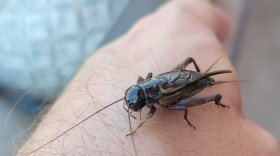The hot, dry summer this year was stressful — not just for us Texans, but also for the flora and fauna around us.
The City of San Marcos removed three pecan trees from City Park this week. Officials with the city’s Parks and Recreation Department said the trees died due to drought stress and disease.
Kelly Eby, San Marcos' urban forester, said pecan trees usually live around 200 years, but these had their lives cut short significantly. And there are lots of other trees dying in the region.
“Urban environments are really tough on trees,” Eby said. The soil quality is less healthy than in a forest environment, because there are fewer leaves and branches decomposing around the tree.
City life for trees is also less nurturing; people can come in and trim back large branches, build things nearby and cut down neighboring vegetation. Trees communicate with each other through a root network, Eby said, so it can get pretty lonely being an urban tree.
“Trees in a park are like [animals in] a zoo,” Eby said. “It’s really strange and kind of foreign, and [they’re] just thrown out there trying to tough it out versus in a forest where they’re all working together.”
Alison Baylis, regional urban ecologist with the Texas A&M Forest Service, said one year of tough weather on trees isn’t too bad, but Central Texas has been seeing year after year of droughts, floods and winter storms.
“It’s hard to believe this, but there are areas in Texas right now that aren’t even in a drought, they’re not even abnormally dry,” Baylis said. “It’s really sort of this pocket in Central Texas and some other areas that are in that extreme and exceptional drought.”
A rough environment and ongoing rough weather can leave trees weak and prone to sickness.
“Things like disease, fungus or insects will come and help take the trees out the rest of the way,” Eby said.
It can sometimes be tricky to tell if a tree is dead. The best practice is to get a certified arborist to come and inspect your trees once a year, especially if a tree extends over your home. Eby said sometimes trees shed all their leaves to conserve energy and water during a drought, but they’re still alive.
“However, if the tree suddenly turns brown and the leaves are still attached to the branch, that tree might have suddenly died,” she said.
Eby said a tree could also look totally fine on the outside, but it could be breaking down and decaying on the inside. She said trees that far gone could fall and hurt someone.
“I don’t want to remove trees … but we have to think about that safety aspect,” she said.
The City of San Marcos plans to plant 48 trees of different varieties in City Park this fall. Eby said she’s looking forward to creating more shade at the park and a more forest-like environment for the trees.
The Parks and Recreation Department is also hosting a tree giveaway on Saturday, Nov. 4, at City Park from 10 a.m. to 1:30 p.m. or until supplies last. There’s a limit of two trees per household, and residents can choose from a variety of native trees. The department said volunteers will be on-site to help people find the right trees for their yards.





















